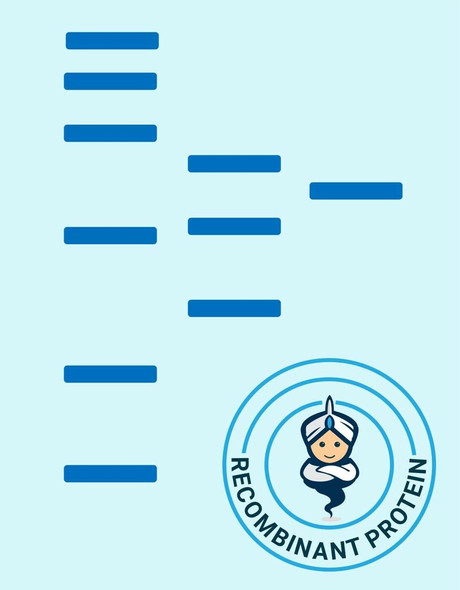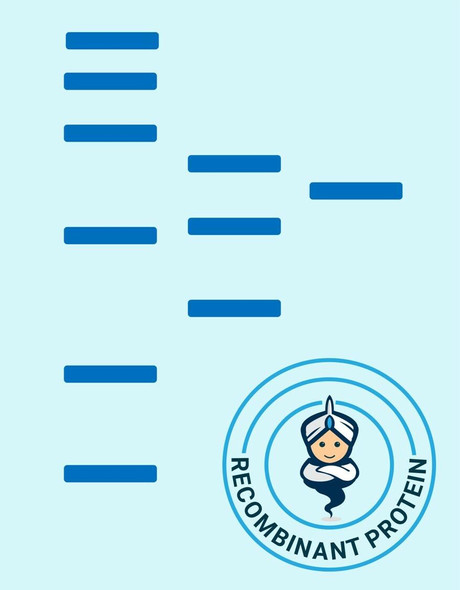Human FGF17 Recombinant Protein (RPPB0231)
- SKU:
- RPPB0231
- Product type:
- Recombinant Protein
- Size:
- 25ug
- Species:
- Human
- Target:
- FGF17
- Synonyms:
- Fibroblast growth factor 17
- FGF-17
- FGF17
- FGF-13
- Source:
- Escherichia Coli
- Uniprot:
- O60258
Description
| Product Name: | Human FGF17 Recombinant Protein |
| Product Code: | RPPB0231 |
| Size: | 25µg |
| Species: | Human |
| Target: | FGF17 |
| Synonyms: | Fibroblast growth factor 17, FGF-17, FGF17, FGF-13, HH20. |
| Source: | Escherichia Coli |
| Physical Appearance: | Sterile Filtered White lyophilized (freeze-dried) powder. |
| Formulation: | FGF17 protein was lyophilized from a 0.2µm filtered concentrated solution in PBS, pH 7.4. |
| Solubility: | It is recommended to reconstitute the lyophilized FGF17 in sterile 18M?-cm H2O not less than 100µg/ml, which can then be further diluted to other aqueous solutions. |
| Stability: | Lyophilized FGF17 although stable at room temperature for 3 weeks, should be stored desiccated below -18°C. Upon reconstitution FGF17 should be stored at 4°C between 2-7 days and for future use below -18°C. For long term storage it is recommended to add a carrier protein (0.1% HSA or BSA). Please prevent freeze-thaw cycles. |
| Purity: | Greater than 95.0% as determined by: (a) Analysis by RP-HPLC.(b) Analysis by SDS-PAGE. |
| Amino Acid Sequence: | MTQGENHPSP NFNQYVRDQG AMTDQLSRRQ IREYQLYSRT SGKHVQVTGR RISATAEDGN KFAKLIVETD TFGSRVRIKG AESEKYICMN KRGKLIGKPS GKSKDCVFTE IVLENNYTAF QNARHEGWFM AFTRQGRPRQ ASRSRQNQRE AHFIKRLYQG QLPFPNHAEK QKQFEFVGSA PTRRTKRTRR PQPLT |
| Biological Activity: | Fully biologically active when compared to standard. The ED50 as determined by a cell proliferation assay using murine balb/c 3T3 cells is less than 10 ng/ml, corresponding to a specific activity of >1.0 × 100,000 IU/mg. |
Fibroblast Growth Factor 17 (FGF17) belongs to the fibroblast growth factor (FGF) family. FGF family members have broad mitogenic and cell survival activities, and are involved in various biological processes including embryonic development cell growth, morphogenesis, tissue repair, tumor growth and invasion. The FGF17 gene is highly expressed in the cerebellum and cortex. The mouse homolog of the FGF17 gene is localized to specific sites in the midline structures of the forebrain, the midbrain-hindbrain junction, developing skeleton and developing arteries, suggesting a role in central nervous system, bone and vascular development.
FGF17 Human Recombinant produced in E.Coli is a single, non-glycosylated, polypeptide chain containing 195 amino acids and having a molecular mass of 22.6kDa.
| UniProt Protein Function: | FGF17: Plays an important role in the regulation of embryonic development and as signaling molecule in the induction and patterning of the embryonic brain. Required for normal brain development. Belongs to the heparin-binding growth factors family. 2 isoforms of the human protein are produced by alternative splicing. |
| UniProt Protein Details: | Protein type:Secreted; Secreted, signal peptide; Cytokine Chromosomal Location of Human Ortholog: 8p21 Cellular Component: extracellular region; extracellular space Molecular Function:1-phosphatidylinositol-3-kinase activity; phosphatidylinositol-4,5-bisphosphate 3-kinase activity; protein-tyrosine kinase activity; Ras guanyl-nucleotide exchange factor activity; type 1 fibroblast growth factor receptor binding; type 2 fibroblast growth factor receptor binding Biological Process: cell-cell signaling; fibroblast growth factor receptor signaling pathway; MAPKKK cascade; nervous system development; phosphoinositide-mediated signaling; regulation of phosphoinositide 3-kinase cascade; signal transduction Disease: Hypogonadotropic Hypogonadism 20 With Or Without Anosmia |
| NCBI Summary: | This gene encodes a member of the fibroblast growth factor (FGF) family. Member of the FGF family possess broad mitogenic and cell survival activities, and are involved in a variety of biological processes including embryonic development cell growth, morphogenesis, tissue repair, tumor growth and invasion. This protein is expressed during embryogenesis and in the adult cerebellum and cortex and may be essential for vascular growth and normal brain development. Mutations in this gene are the cause of hypogonadotropic hypogonadism 20 with or without anosmia. Alternate splicing results in multiple transcript variants. [provided by RefSeq, Jan 2015] |
| UniProt Code: | O60258 |
| NCBI GenInfo Identifier: | 6015147 |
| NCBI Gene ID: | 8822 |
| NCBI Accession: | O60258.1 |
| UniProt Secondary Accession: | O60258,Q2M2W1, B7ZLG4, |
| UniProt Related Accession: | O60258 |
| Molecular Weight: | 23,669 Da |
| NCBI Full Name: | Fibroblast growth factor 17 |
| NCBI Synonym Full Names: | fibroblast growth factor 17 |
| NCBI Official Symbol: | FGF17 |
| NCBI Official Synonym Symbols: | HH20; FGF-13; FGF-17 |
| NCBI Protein Information: | fibroblast growth factor 17 |
| UniProt Protein Name: | Fibroblast growth factor 17 |
| Protein Family: | Fibroblast growth factor |
| UniProt Gene Name: | FGF17 |
| UniProt Entry Name: | FGF17_HUMAN |










